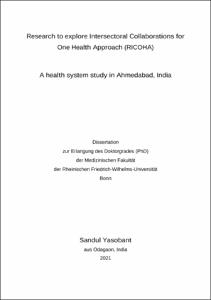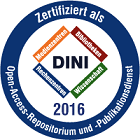Yasobant, Sandul: Research to explore Intersectoral Collaborations for One Health Approach (RICOHA) : A health system study in Ahmedabad, India. - Bonn, 2021. - Dissertation, Rheinische Friedrich-Wilhelms-Universität Bonn.
Online-Ausgabe in bonndoc: https://nbn-resolving.org/urn:nbn:de:hbz:5-61086
Online-Ausgabe in bonndoc: https://nbn-resolving.org/urn:nbn:de:hbz:5-61086
@phdthesis{handle:20.500.11811/8893,
urn: https://nbn-resolving.org/urn:nbn:de:hbz:5-61086,
author = {{Sandul Yasobant}},
title = {Research to explore Intersectoral Collaborations for One Health Approach (RICOHA) : A health system study in Ahmedabad, India},
school = {Rheinische Friedrich-Wilhelms-Universität Bonn},
year = 2021,
month = jan,
note = {The One Health (OH) approach is becoming popular across the globe, and some countries are underway to implement it. For the effective implementation of OH, the operationalization of intersectoral collaboration (ISC) is essential; however, there is a lack of evidence available on factors affecting the degree of collaboration and strategies to enhance it. The factors affecting ISC operationalization are further multifaceted by the health system structure and its degree of resilience. With the dynamic changes of health system resilience and destabilization at the interfaces of the human-animal-environment, the implementation of OH is becoming mercurial. Therefore, the Research to explore Intersectoral Collaboration for One Health Approach (RICOHA) study attempted to understand the health system complexity for operationalization of ISC with the help of a systems approach.
The RICOHA study used mixed-methods, where both qualitative and quantitative health system data were collected between September 2018 to October 2019 in one of the western cities of India, Ahmedabad. The exploration process started with the prioritization of diseases followed by a bottom-up approach data collection process. The data was first collected from the community level (supply-side: health system actors and demand side: households) and progressed upwards to the provider level (clinicians such as physicians, veterinarians) and then to the administrative level with managers, decision-makers, program coordinators from the human and animal health system. The qualitative data were collected through key informant interviews, focus group discussions, participatory workshops, vignettes, and modified policy Delphi method, to prioritize diseases, understand the current degree of collaboration, and to document what factors influence collaboration. The quantitative data was collected through cross-sectional surveys to understand the network cohesion of the health system actors and to capture the zoonotic disease awareness level, including the practices. The software packages used were Atlas. Ti version 7 for qualitative data, R version 3.4.1 for quantitative data, UCINET 6 for network data, and Sensitivity Model of Vester to explore the system factors.
The RICOHA study prioritized zoonotic diseases such as rabies, brucellosis, avian influenza (H5N1), influenza A (H1N1), which require collaborative efforts from the human and animal health system for its effectual prevention and control in the local setting of Ahmedabad, India. This research explored all potential OH actors across the three health system levels (i.e., administrative, provider, community) from the human and the animal health system. In addition to the presence of the city level actors, there was another layer of administrative actors of the top authorities (either from district/state/nation) found to have an integral role in decision making in the prevention of zoonoses. Although the administrative actors of the human and the animal health system have collaborated as instructed by the top authorities during outbreak situations, there was a low network cohesion during non-outbreak situations. In addition, there was low interest in collaborative activities among the actors of the provider level, and the private and non-governmental actors were not integrated into collaborative activities. As RICOHA identified a lack of community actors from the animal health system, the human health community workers' vibrant presence was investigated for the level of motivation to act as OH activists. Despite the low motivation among the community health workers, some have produced an interest in acting as OH activists if additional financial incentives are provided to them. Overall, there is low interest in ISC, and a low acknowledgment of the advantages of ISC has been documented in this study. ISC is instead considered a burden and would not be operationalized unless the top authorities were instructed to do so. However, in the short term, the third-party based ISC could be envisaged by addressing the micro enablers identified at the individual level. Whereas in the long term, level-based ISC is recommended after addressing the organizational and systemic factors identified in the local context. RICOHA study contributed both conceptually and empirically to the OH implementation process. The documented innovative ISC strategies from this study might assist the ISC operationalization process in Ahmedabad. In addition, the bottom-up approach of exploring a health system also envisaged a useful method in health system research towards developing the people-centered health system. Thus, this study concludes that not only ISC is needed for OH among the sectors pertaining to the human and the animal health system but also across the governance level for effective implementation.},
url = {https://hdl.handle.net/20.500.11811/8893}
}
urn: https://nbn-resolving.org/urn:nbn:de:hbz:5-61086,
author = {{Sandul Yasobant}},
title = {Research to explore Intersectoral Collaborations for One Health Approach (RICOHA) : A health system study in Ahmedabad, India},
school = {Rheinische Friedrich-Wilhelms-Universität Bonn},
year = 2021,
month = jan,
note = {The One Health (OH) approach is becoming popular across the globe, and some countries are underway to implement it. For the effective implementation of OH, the operationalization of intersectoral collaboration (ISC) is essential; however, there is a lack of evidence available on factors affecting the degree of collaboration and strategies to enhance it. The factors affecting ISC operationalization are further multifaceted by the health system structure and its degree of resilience. With the dynamic changes of health system resilience and destabilization at the interfaces of the human-animal-environment, the implementation of OH is becoming mercurial. Therefore, the Research to explore Intersectoral Collaboration for One Health Approach (RICOHA) study attempted to understand the health system complexity for operationalization of ISC with the help of a systems approach.
The RICOHA study used mixed-methods, where both qualitative and quantitative health system data were collected between September 2018 to October 2019 in one of the western cities of India, Ahmedabad. The exploration process started with the prioritization of diseases followed by a bottom-up approach data collection process. The data was first collected from the community level (supply-side: health system actors and demand side: households) and progressed upwards to the provider level (clinicians such as physicians, veterinarians) and then to the administrative level with managers, decision-makers, program coordinators from the human and animal health system. The qualitative data were collected through key informant interviews, focus group discussions, participatory workshops, vignettes, and modified policy Delphi method, to prioritize diseases, understand the current degree of collaboration, and to document what factors influence collaboration. The quantitative data was collected through cross-sectional surveys to understand the network cohesion of the health system actors and to capture the zoonotic disease awareness level, including the practices. The software packages used were Atlas. Ti version 7 for qualitative data, R version 3.4.1 for quantitative data, UCINET 6 for network data, and Sensitivity Model of Vester to explore the system factors.
The RICOHA study prioritized zoonotic diseases such as rabies, brucellosis, avian influenza (H5N1), influenza A (H1N1), which require collaborative efforts from the human and animal health system for its effectual prevention and control in the local setting of Ahmedabad, India. This research explored all potential OH actors across the three health system levels (i.e., administrative, provider, community) from the human and the animal health system. In addition to the presence of the city level actors, there was another layer of administrative actors of the top authorities (either from district/state/nation) found to have an integral role in decision making in the prevention of zoonoses. Although the administrative actors of the human and the animal health system have collaborated as instructed by the top authorities during outbreak situations, there was a low network cohesion during non-outbreak situations. In addition, there was low interest in collaborative activities among the actors of the provider level, and the private and non-governmental actors were not integrated into collaborative activities. As RICOHA identified a lack of community actors from the animal health system, the human health community workers' vibrant presence was investigated for the level of motivation to act as OH activists. Despite the low motivation among the community health workers, some have produced an interest in acting as OH activists if additional financial incentives are provided to them. Overall, there is low interest in ISC, and a low acknowledgment of the advantages of ISC has been documented in this study. ISC is instead considered a burden and would not be operationalized unless the top authorities were instructed to do so. However, in the short term, the third-party based ISC could be envisaged by addressing the micro enablers identified at the individual level. Whereas in the long term, level-based ISC is recommended after addressing the organizational and systemic factors identified in the local context. RICOHA study contributed both conceptually and empirically to the OH implementation process. The documented innovative ISC strategies from this study might assist the ISC operationalization process in Ahmedabad. In addition, the bottom-up approach of exploring a health system also envisaged a useful method in health system research towards developing the people-centered health system. Thus, this study concludes that not only ISC is needed for OH among the sectors pertaining to the human and the animal health system but also across the governance level for effective implementation.},
url = {https://hdl.handle.net/20.500.11811/8893}
}






